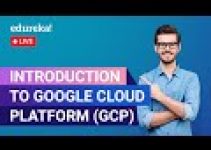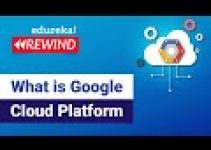It’s amazing what is going on at Google. Watch this video that gives an insight into the technology coming soon in Google’s cloud.
Hey, welcome back everybody. Jeff Frick here with theCUBE, we are on the ground in downtown San Francisco at the Google Next 17 Conference. It’s this crazy conference week, and arguably this is the center of all the action. Cloud is big, Google Cloud Platform is really coming out with a major enterprise shift and focus, which they’ve always had, but now they’re really getting behind it.
And I think this conference is over 14,000 people, has grown quite a bit from a few years back, and we’re really excited to have one of the powerhouse partners with Google, who’s driving to the enterprise, and that’s Intel, and I’m really excited to be joined by Raejeanne Skillern, she’s the VP and GM of the Cloud Platform Group, Raejeanne, great to see you. >> Thank you, thanks for having me. >> Yeah absolutely. So when we got this schedule, I was thinking, wow, last time I saw you were at the Open Compute Project 2015, and we were just down there yesterday. >> Yesterday. And we missed each other yesterday, but here we are today. >> So it’s interesting, there’s kind of the guts of the cloud because the cloud is somebody else’s computer that they’re running, but there is actually a computer back there. Here, it’s really kind of the front end and the business delivery to people to have the elastic capability of the cloud, the dynamic flexibility of the cloud, and you guys are a big part of this.
So first off, give us a quick update, I’m sure you had some good announcements here at the show, what’s going on with Intel and Google Cloud Platform? >> We did, and we love it all, from the silicon ingredients up to the services and solutions, this is where we invest, so it’s great to be a part of yesterday and today. I was on stage earlier today with Urs Holzle talking about the Google and Intel Strategic Alliance, we actually announced this alliance last November, between Diane Green and Diane Bryant of Intel. And we had a history, a decade-plus long of collaborating on CPU level optimization and technology optimization for Google’s infrastructure. We’ve actually expanded that collaboration to cover hybrid cloud orchestration, security, IOT edge to the cloud, and of course, artificial intelligence, machine learning, and deep learning. So we still do a lot of custom work with Google, making sure our technologies run their infrastructure the best, and we’re working beyond the infrastructure to the software and solutions with them to make sure that those software and solutions run best on our architecture.
>> Right cause it’s a very interesting play, with Google and Facebook and a lot of the big cloud providers, they custom built their solutions based on their application needs and so I would presume that the microprocessor needs are very specific versus say, a typical PC microprocessor, which has a more kind of generic across the board type of demand. So what are some of the special demands that cloud demands from the microprocessor specifically? >> So what we’ve seen, right now, about half the volume we ship in the public cloud segment is customized in some way.
And really the driving force is always performance per dollar TCO improvement. How to get the best performance and the lowest cost to pay for that performance. And what we’ve found is that by working with the top, not just the Super Seven, we call them, but the Top 100, closely, understanding their infrastructure at scale, is that they benefit from more powerful servers, with performance efficiency, more capability, more richly configured platforms. So a lot of what we’ve done, these cloud service providers have actually in some cases pushed us off of our roadmap in terms of what we can provide in terms of performance and scalability and agility in their infrastructure.
So we do a lot of tweaks around that. And then of course, as I mentioned, it’s not just the CPU ingredients, we have to optimize in the software level, so we do a lot of co-engineering work to make sure that every ounce of performance and efficiency is seen in their infrastructure. And that’s how they, their data center is their cost to sales, they can’t afford to have anything inefficient.
So we really try to partner to make sure that it is completely tailor-optimized for that environment. >> Right, and the hyperscale, like you said, the infrastructure there is so different than kind of classic enterprise infrastructure, and then you have other things like energy consumption, which, again, at scale, itty bitty little improvements >> It’s expensive. >> Make a huge impact. And then application far beyond the cloud service providers, so many of the applications that we interact with now today on a day to day basis are cloud-based applications, whether it is the G Suite for documents or this or that, or whether it’s Salesforce, or whether we just put in Asana for task tracking, and Slack and so many of these things are now cloud-based applications, which is really the way we work more and more and more on our desktops.
>> Absolutely. And one of the things we look at is, applications really have kind of a gravity. Some applications are going to have a high affinity to the public cloud. You see Tustin Dove, you see email and office collaboration already moving into the public cloud. There are some legacy applications, complex, some of the heavier modeling and simulation type apps, or big huge supercomputers that might stay on premise, and then you have this middle ground of applications, that, for various reasons, performance, security, data governance, data gravity, business need or IP, could go between the public cloud or stay on premise. And that’s why we think it’s so important that the world recognizes that this really is about a hybrid cloud.
And it’s really nice to partner with Google because they see that hybrid cloud as the end state, or they call it the Multi-Cloud. And their Kubernetes Orchestration Platform is really designed to help that, to seamlessly move those apps from on a customer’s premise into the Google environment and have that flow. So it’s a very dynamic environment, we expect to see a lot of workloads kind of continue to be invested and move into the public cloud, and people really optimizing end-to-end. >> So you’ve been in the data center space, we talked a little bit before we went live, you’ve been in the data center space for a long, long time. >> Long time. >> We won’t tell you how long.
(laughing) >> Both: Long time. >> So it must be really exciting for you to see this shift in computing. There’s still a lot of computing power at the edge, and there’s still a lot of computing power now on our mobile devices and our PCs, but so much more of the heavy lift in the application infrastructure itself is now contained in the data center, so much more than just your typical old-school corporate data centers that we used to see. Really fun evolution of the industry, for you. >> Absolutely, and the public cloud is now one of the fastest growing segments in the enterprise space, in the data center space, I should say. We still have a very strong enterprise business. But what I love is it’s not just about the fact that the public cloud is growing, this hybrid really connects our two segments, so I’m really learning a lot.
It’s also, I’ve been at Intel 23 years, most of it in the data center, and last year, we reorganized our company, we completely restructured Intel to be a cloud and IoT company. And from a company that for multiple decades was a PC or consumer-based client device company, it is just amazing to have data center be so front and center and so core to the type of infrastructure and capability expansion that we’re going to see across the industry. We were talking about, there isn’t going to be an industry left untouched by technology. Whether it’s agriculture, or industrial, or healthcare, or retail, or logistics. Technology is going to transform them, and it all comes back to a data center and a cloud-based infrastructure that can handle the data and the scale and the processing. >> So one of the new themes that are really coming on board, next week will it be a Big Data SV, which has grown out of Hadoop and the old big data conversation. But it’s really now morphing into the next stage of that, which is machine learning, deep learning, artificial intelligence, augmented reality, virtual reality, so this whole ‘nother round that’s going to eat up a whole bunch of CPU capacity.
But those are really good cloud-based applications that are now delivering a completely new level of value and application sophistication that’s driven by power back at the data center. >> Right. We see artificial intelligence has been a topic since the 50s. But the reality is, the technology is there today to both capture and create the data, and compute on the data. And that’s really unlocking these capabilities. And from us as a company, we see it as really something that is going to not just transform us as a business but transform the many use cases and industries we talked about. Today, you or I generate about a gig and a half of data, through our devices and our PC and tablet. A smart factory or smart plane or smart car, autonomous car, is going to generate terabytes of data. Right, and that is going to need to be stored. Today it’s estimated only about 5% of the data captured is used for business insight. The rest just sits. We need to capture the data, store the data efficiently, use the data for insights, and then drive that back into the continuous learning.
And that’s why these technologies are so amazing, what they’re going to be able to do because we have the technology and the opportunity in the business space, whether it’s AI for play or for good or for business, AI is going to transform the industry. >> It’s interesting, Moore’s Law comes up all the time. People, is Moore’s Law done, is Moore’s Law done? And you know, Moore’s Law is so much more than the physics of what he was describing when he first said that in the first place, about the number of transistors on a chip. It’s really about an attitude, about this unbelievable drive to continue to innovate and iterate and get these order of magnitude of increase. We talked to David Floyer at OCP yesterday, and he’s talking about it’s not only the microprocessors and the compute power, but it’s the IO, it’s the networking, it’s storage, it’s flash storage, it’s the interconnect, it’s the cabling, it’s all these things.
And he was really excited that we’re getting to this massive tipping point, of course in five years we’ll look back and think it’s archaic, of these things really coming together to deliver low latency almost magical capabilities because of this combination of factors across all those different, kind of the three horsemen of computing, if you will, to deliver these really magical, new applications, like autonomous vehicles. >> Absolutely. And we, you’ll hear Intel talk about Jevons Paradox, which is really about, if you take something and make it cheaper and easier to consume, people will consume more of it.
We saw that with virtualization. People predicted oh everything’s going to slow down cause you’re going to get higher utilization rates. Actually, it just unlocked new capabilities and the market grew because of it. We see the same thing with data. Our CEO will talk about, data is the new oil. It is going to transform, it’s going to unlock business opportunity, revenue growth, cost savings in the environment, and that will cause people to create more services, build new businesses, reach more people in the industry, transform traditional brick and mortar businesses to the digital economy. So we think we’re just on the cusp of this transformation, and the next five to 10 years is going to be amazing. >> So before we let you go, again, you’ve been doing this for 20 plus years, I wasn’t going to say anything, she said it, I didn’t say it, and I worked at Intel the same time, so that’s good.
As you look forward, what are some of your priorities for 2017, what are some of the things that you’re working on, that if we get together, hopefully not in a couple years at OCP, but next year, that you’ll be able to report back that this is what we worked on and these are some of the new accomplishments that are important to me? >> So I’m really, there’s a number of things we’re doing. You heard me mention artificial intelligence many, many times. In 2016, Intel made a number of significant acquisitions and investments to really ensure we have the right technology roadmap for artificial intelligence. Machine learning, deep learning, training, and inference. And we’ve really shored up that product portfolio, and you’re going to see these products come to market and you’re going to see user adoption, not just in my segment, but transforming multiple segments. So I’m really excited about those capabilities. And a lot of what we’ll do, too, will be very vertical-based. So you’re going to see the power of the technology, solving the health care problem, solving the retail problem, solving manufacturing, logistics, industrial problems.
So I like that, I like to see tangible results from our technology. The other thing is the cloud is just growing. Everybody predicted, can it continue to grow? It does. Companies like Google and our other partners, they keep growing and we grow with them, and I love to help figure out where they’re going to be two or three years from now and get our products ready for that challenge. >> Alright, well I look forward to our next visit.
Raejeanne, thanks for taking a few minutes out of your time and speaking to us. >> It was nice to see you again. >> You too. Alright, she’s Raejeanne Skillern and I’m Jeff Frick, you’re watching theCUBE, we’re at the Google Cloud Next Show 2017, thanks for watching. (electronic sounds).
There is a lot going on, please share this link.


